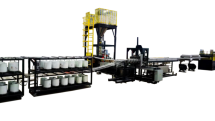Features:
The main system consists of a non-intermeshing twin-screw feeding section, a twin-rotor kneading section, and a twin-screw discharge section. Among them, the twin-rotor structure similar to an internal mixer has been optimized for design, enabling processes such as plasticization, melting, pushing, shearing, and kneading of polymer material systems.
Unlike co-rotating twin-screws, the two kneading rotors rotate at high speed in opposite directions without meshing. Additionally, there is no backpressure control device, significantly increasing the ability to adjust residence time, filling degree, and kneading degree, thus offering greater operational flexibility and energy efficiency. This ensures more thorough mixing and dispersion quality.
Compared to twin-screw extruders, it offers better tolerance and adaptability to raw material size (loose or large chunks).
It adopts a new extended twin-kneading section rotor design, enhancing degassing and kneading effects as well as application range.
It features various types of rotor structures combined with a variable embedded barrel structure, allowing for flexible adjustments of key structural parameters to meet different material and process requirements.
The main barrel has a split structure, facilitating cleaning, maintenance, and material changes.
The kneading rotors have a dual-support structure at both ends, enhancing rigidity and avoiding direct friction and unnecessary wear between the screws and the barrel, which can occur in twin-screw extruders.
Typical Applications:
High-filler compounding and modification; filler masterbatches, specialty compounds, functional masterbatches, high-concentration color masterbatches, carbon black masterbatches, flame-retardant masterbatches, shielding materials, elastomers, and rubber-plastic blends.





 Whats App
Whats App
 PlastMatch App
Scan the QR code
PlastMatch App
Scan the QR code 1000+ Daily Updated Global Business Leads,2M+ Global Company Database.Click to download the app.
Purchase request Download app